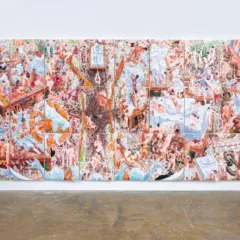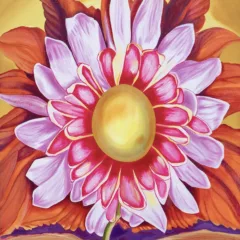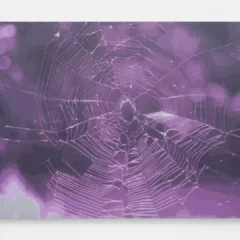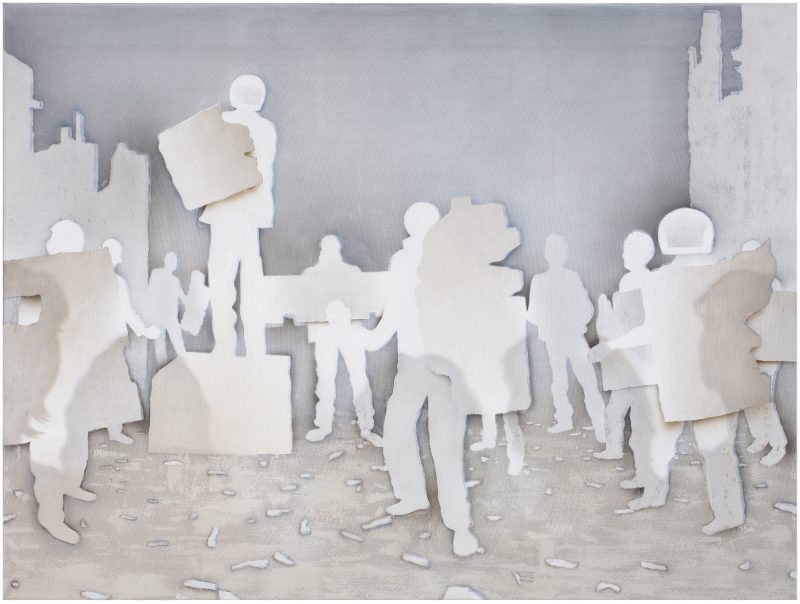
photo by James Wade
Anachronism and Liberation, curated by Mary Henderson and Jane Irish, now showing at Tiger Strikes Asteroid’s new gallery in the Crane Arts building, consists of twelve works of art by nine accomplished artists. The exhibition claims to present “political art” — art which both connects to the traditional, responds to what is transpiring in the present, and in some way surpasses that.
Portrait of revolution
“Square,” an absolutely stunning mixed-media painting by Alexi Worth, is part of his series relating to the Arab Spring. An urban landscape featuring figures protesting the corrupt government in Egypt, this large work, on a textured mesh, is ethereal, almost ghostly. Worth has described it as follows: “In a ragged, ruined city, eleven male figures (inspired by the counter-government protesters in Tahrir Square, Egypt) hold stones and ad-hoc shields which bear the large silhouette-like shadows of spectators.”
The image of protesters in the process of overthrowing an autocratic, repressive government, with the shadows of a world of spectators looking on, conveys a degree of hope (and fits into the curators’ theme of liberation), which contrasts sharply with the powerlessness that many of us feel in today’s political moment. Interestingly, the piece does not seem to reflect the tragic fact that the Arab Spring in Egypt soon turned to winter, even though I understand that Worth began this series in 2013, when it was quite clear that the country was about to fall into the hands of the military.
Portrait of hope – “Let’s travel at magnificent speeds around the Universe”
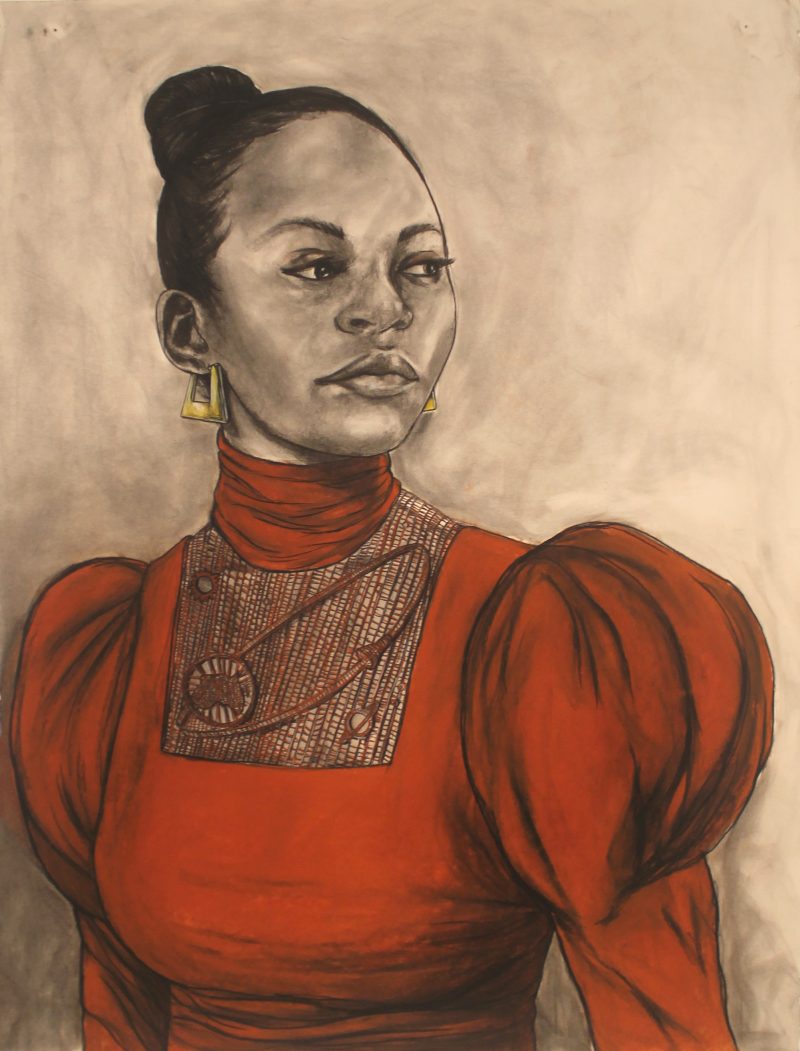
Robert Pruitt’s remarkable and stately portrait of a beautiful African American woman, “Let’s travel at magnificent speeds around the Universe,” epitomizes both themes of the exhibition, anachronism and liberation. The pride and determination carried by this woman and captured by the artist is remarkable. The work reminds me of a photograph of Marion Anderson that sits in the National Portrait Gallery, a portrait of a woman who projects the same soulful characteristics and strength. The intriguing title of Pruitt’s piece expresses the hope that the portrait conveys, and also the aspirations of the exhibition as a whole.
Portrait of a woman under pressure
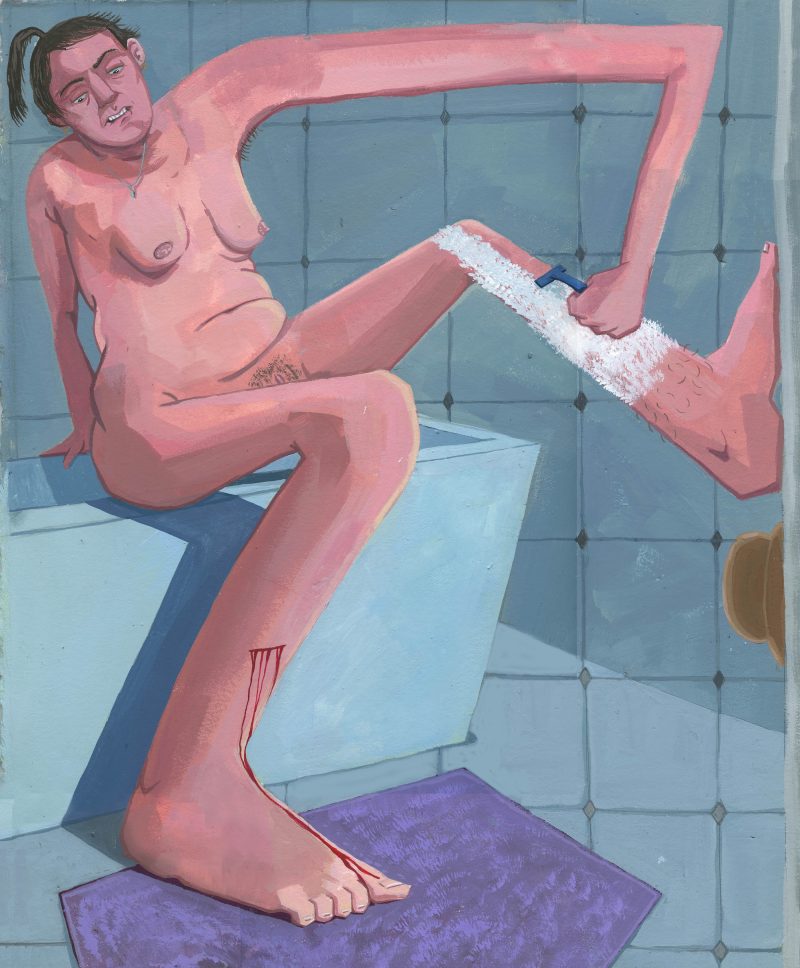
In their publicity materials, the curators have chosen to highlight the work of a young artist, Rebecca Ness, who is about to begin an MFA program at Yale. Ness has two small pieces in the show, both gouache and graphite on paper, one titled “Mistake,” the other “Getting Desirable II,” which I gather are part of a series of works she has produced over the last year or so featuring the same character.
Ness’s almost strange, disproportionate image of this woman shaving her legs (we’re told she’s preparing for a date), and bleeding, is disturbing. There is something exquisitely raw about the figure – in part, obviously a function of her almost sunburn skin tones – including her dazed look of anguish, which repudiates or parodies almost every female physical attribute which has been bastardized and stereotyped as an accoutrement of beauty over the ages (and of course no less by Madison Avenue and Hollywood) and pounded into our heads.
There’s another equally harsh piece in this series of Ness’s work (not exhibited at Tiger) titled “I started this painting pre-election and finished it post-election,” in which the same woman is pictured shaving her pubic hair. This reminded me of a Dana Schutz painting, “Shaving,” in which a disarranged figure of a woman on a beach is engaged in the same activity. Schutz’s work, by contrast to Ness’s, however, is stylish, perhaps even humorous. Indeed, if Ness’s brilliant portrayal of the contortions forced upon them doesn’t lead you to question what our society does to women, even in today’s far more liberated world, I don’t know what will.
Novel approaches, traditional modalities
There are many other equally powerful pieces on display in the show, works that tackle subjects ranging from police brutality, to ecological trauma, to colonization. A disquieting, caliginous painting by Charles Edward Williams, “Confrontation III,” with an illuminated hand outstretched to the world, apparently inspired by Gerhard Richter’s “The October 18, 1977” series (from the Baader-Meinhof era), relates to the 2014 chokehold death of a black man, Eric Garner, at the hands of white policemen in Staten Island. A fine and decorative porcelain teapot sculpted and painted by Robert Lugo — demonstrating a mastery of this age-old commemorative art — turns out to feature an image of abolitionist Frederick Douglass (as well as a self-portrait of the artist), and literally was formed in part using dirt from Lugo’s Philadelphia neighborhood. Han Wang’s three equally masterful porcelain flowered chickens, what she refers to as “contemporary Chinoiserie,” explore gender stereotypes (apparently “chicken” is pejorative for women in Chinese), but at the same time reflect the lifespan of women from youth to middle age to old age.
There is no weakness among the twelve pieces on display in this show. The work of each of the artists is skillful and engaging. I don’t think they all work perfectly together, but how could they? One thing for sure though – this is an important exhibition, demonstrating the efforts of nine talented artists — also including noteworthy works by Ana Hernandez, Odili Odita, and Lisi Raskin — who are grappling with some of the most critical issues of our time, and in their own way guiding us into the future.
If you visit the show, the gallery’s one-room space in the Crane is more elegant (though not quite as bright) as its previous home on 11th Street. Fjord Gallery and the Spillway Collective also now join Icebox Project Space in the building, so there’s lots to see.
Anachronism and Liberation, through Sept. 14, 2017, Tiger Strikes Asteriod, 1400 N. American St. #107


